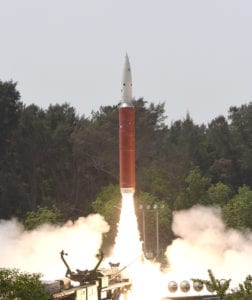by Doug Loverro

In the not-so-distant future, some country’s leader will be forced to answer the following question – will they passively allow the citizens and military forces of their nation to be targeted, with impunity, by the space forces of an adversary nation? Will they countenance thousands of sailors on a major surface combatant being killed by a missile strike guided to its target by an overhead satellite and be forced to accept that as a consequence of agreeing to shun any and all attacks on space systems? Or will they decide to act?
The unavoidable answer is, of course they will act. Given the choice between the loss of thousands, hundreds, or even tens of lives, versus the disabling or destruction of an unmanned space system, no national leader would agree that preservation of the space system was the higher good. In fact, just the opposite – it would be their sovereign duty to take every possible measure to remove that system from the targeting chain of their adversary to preserve those lives. Which is why such a future is inevitable and why we must rethink how we will deal with international discussions on attacks against space systems and anti-satellite (ASAT) weapons.
Anti-Satellites: A Brief History
Anti-satellite activity has been with us since the beginning of the space age. In the U.S., the earliest documented tests of ASAT weapons came less than two years after the launch of the first American satellite. As part of the “Bold Orion” program, an air launched ICBM research effort that began in 1958, a final test culminated in the simulated intercept of the Explorer VI satellite.[1] While “Bold Orion” never became operational, a follow-on program, “Project MUDFLAP”, utilizing a ground-launched NIKE-ZEUS missile did in 1963.[2] Later acknowledged U.S. ASAT testing involved everything from fighter launched missiles to ground-based lasers. Meanwhile, the Soviet Union began its own ASAT research program in the early 1960s. Their co-orbital ASAT system began testing in 1963, became operational about 10 years later in 1973, and remained active through the end of the Cold War. [3]
ASAT activity receded from the mainstream following the end of the Cold War, but research into technologies that could be used for ASAT purposes never truly abated. This ranged from tests of missile defense and proximity operation technologies in the U.S. to purported high power microwave and laser system tests in Russia. Throughout the next few decades several nations fielded systems to counter both space-based communications and navigation systems using ground-based electronic methods, but in-space or “into space” ASAT activity, if it existed, seemed to diminish in importance. It would not be gone for long.
By the early 2000s, following the first Gulf War, the war in Kosovo, and the initial stages of conflict in Afghanistan and Iraq, it became abundantly clear to many nations that space systems were the key link in U.S. power projection. It also became clear that link was a critical vulnerability in U.S. strategy. Chinese strategic writings from that period termed the U.S. reliance on space as its “soft ribs”, stating “for countries that can never win a war with the United States by using the method of tanks and planes, attacking U.S. space systems may be an irresistible and most tempting choice.”[4] Not long thereafter, the Chinese embarked on a wide range of ASAT weapons development, famously shooting down one of its own satellites in January 2007 and creating a massive level of long-lived debris in its wake.[5]
The Chinese were not alone, Russia resumed or accelerated research into multiple ASAT programs,[6] the U.S. demonstrated that a highly modified Standard Missile-3, part of its ABM system, could be used for ASAT purposes,[7]and even India demonstrated their ability to use a ground-based missile to down their own target satellite.[8] The ASAT club now included at least four nations, and with the accelerating democratization of space technology, there appeared to be no major impediment to prevent others from joining.
Failure of Space Arms-Control
As nations commenced the exploration and exploitation of space, so too did they begin to discuss the body of rules that would accompany that journey. In the 1960s, only a very few nations had the technological capacity to engage in space activities. But with the backdrop of the Cold War and rapid technological advances, nations recognized that a rule set to guide actions in the new domain were in their combined interest. So it was that in December of 1966, the 28 members of the United Nations Outer Space Committee achieved agreement on a set of principles that would govern international conduct in the domain. Coming less than 10 years after the first man-made object entered space, this was indeed a remarkable achievement. The Treaty on Principles Governing the Activities of States in the Exploration and Use of Outer Space, Including the Moon and Other Celestial Bodies (informally, the Outer Space Treaty) stands today as the most important international space agreement.
While the treaty assured the use of space for peaceful purposes, it did not, contrary to what many suppose, restrict it to that use. In fact, the language of the treaty makes clear that while “celestial bodies” might be used “exclusively for peaceful purposes”,[9] that prohibition did not extend to space itself. This lack of application of “exclusively peaceful” to space was in recognition that both the U.S. and the Soviet Union were already engaging in military uses of space systems, and they did not want that subject to be raised in the multi-lateral United Nations forum while such discussions were already underway in their bilateral disarmament negotiations.[10]
Since 1967, other multi-lateral space treaties, principles, and resolutions have been added to the body of space law.[11] But no new space arms control instrument has been agreed to since that time notwithstanding decades of efforts. Since the early eighties, attempts at the UN Conference on Disarmament to make progress on an agreement to Prevent an Arms Race in Outer Space (PAROS) have met with failure despite resolutions affirming those efforts in the first Committee throughout multiple years. More recently, beginning in 2008, and several times since, both Russia and China have presented a draft treaty on the Prevention of the Placement of Weapons in Outer Space (PPWT), but without any real prospect for advancement. And of course, even as Russia and China advanced these space-arms control efforts, their own test and research programs continued unabated. Notably, the U.S. has been one of the more forceful opponents to these efforts, arguing that they are either too incomplete[12] to be effective, lack measures that would allow verification, or fail to distinguish the handling of dual-use satellites.[13]
The concerns expressed by the U.S. and other western countries are no doubt issues that would need to be solved. But historical U.S. opposition to space-arms agreements is likely more fundamental. It is the single largest user of space for its defense, and growing concerns about other nations’ on-orbit or ground-based ASAT efforts place it in the position, at least perceptually, of having the least to gain and the most to lose from any space-arms agreements. Even more concerning, as other nations begin to integrate satellite-based surveillance, reconnaissance, navigation, and communications into their own kill chains, in the same fashion that the U.S. has been doing for decades, the perceived need to preserve the right to counter those systems has grown. All of which places us back where we started – that it is the sovereign right and duty of any nation to protect itself from space-enabled attack, even if that means disabling or destroying a satellite.
Summarizing the preceding – the historical record of ASAT testing coupled with decades-long failure in comprehensive Space Arms control, and viewed against a backdrop of the necessity of sovereign nations to defend themselves from space-enabled attack leads to one inescapable conclusion – it is time to recognize the inevitable. In some future war, anti-Satellite activities will occur – the question we need to deal with is how that will war be fought, and what we need to do now to prepare.
Rethinking the Inevitable
The right of nations to defend themselves is recognized in every aspect of international law. But international law also recognizes that there are limits to that right. Customary rule sets, such as the Laws of Armed Conflict, as well as more formal legal instruments such as the Hague Conventions, the Geneva Protocol[14], and the less widely accepted Ottawa Treaty[15] amongst others, form a body of principles that do not try to outlaw armed conflict, but rather avoid some of the more harmful consequences when it does occur. If space attacks and anti-satellite activities, like war, are inevitable, there is every reason to believe that a similar approach may be necessary.
There is significant international agreement on some of the consequences we would like to avoid. Preventing large-scale generation of long-lived debris, especially in low earth orbit, is one such consequences of unrestricted anti-satellite warfare that enjoys wide support. The universal condemnation of the January 2007 Chinese ASAT test centered not on the fact that they had demonstrated an ASAT capability, but rather that thousands of pieces of hazardous debris were created in its wake. In reality, the aversion to the creation of large-scale, long-lived debris is simply the tacit extension of already existing prohibitions on weapons that cause indiscriminate harm, a principle that underpins many other weapons-type prohibitions.[16] When viewed from this perspective, it seems quite likely that nations could agree on such a ban, even as they continued to permit forms of attack that did not create large-scale, long-lived debris.[17]
The application of customary international law to the issues of space attack are not new. Koplow, in his 2009 treatise on the subject contends that “in the absence of a new outer space disarmament treaty, the world can productively turn to customary international law (CIL) as a viable alternative pathway toward enhancing space security and impeding the development and use of ASATs.” [18] He is correct to a point. While CIL can indeed guide our assessment of the types of prohibitions that might be applied, they are unlikely to operate prospectively in restraining the development or use of ASAT weapons, especially lacking agreement by others to enforce similar constraints. But turning to CIL as a mechanism for advancing limited but negotiable restraints should be seen as a far more likely route to success than the pursuit of wide-ranging agreements such as PAROS or PPWT.
Debris generation as it relates to discriminate harm is perhaps the most obvious application of CIL to the space arena, but it is not unique. Concepts of proportionality could easily be extended, for example, to the realm of global satellite position, navigation, and timing (PNT) capabilities, which have wide-ranging civilian uses, the loss of which could be devastating. In most cases, the localized jamming of such services would likely be justified in proportion to the military objective sought. On the other hand, a global outage of such a service, over any extended period of time, would clearly outweigh most immediate military needs short of global war. If that concept was accepted, then anti-satellite activities that targeted local or transient PNT capabilities would be permitted. But cyber-attacks on central control facilities that disrupted the global system would be prohibited under concepts of proportionality.
The purpose here is not to try to enumerate all the individual space-attack areas in which we might find agreement based on the application of CIL. Rather, it is to indicate that if indeed space attacks are inevitable, then we need to end discussions that try to restrain all forms of attack, and focus our collective efforts instead on those actions which the community of nations would commonly find objectionable.
Doing so implicitly acknowledges acceptance of a future that includes space attacks – an unfortunate but none-the-less inevitable result. But it would aid immeasurably in avoiding the most serious long-term or wide-ranging consequences of such attacks and thus bring space attacks in line with other areas of warfare in trying to limit harm from otherwise unconstrained action. Given the abject failure to reach agreement on space arms talks since 1967, it is time to rethink the inevitable and begin to negotiate the future.
[1] White, J. Terry, Bold Orion’s Grand Finale (White Eagle Aerospace, 2011, https://www.whiteeagleaerospace.com/bold-orions-greatest-moment/)
[2] Hubbs, Mark, Where we began – the NIKE-ZEUS Program (The Eagle, U.S. Army Space and Missile Defense Command, February 2007, https://www.smdc.army.mil/Portals/38/Documents/Publications/History/Eagle%20articles/NIKE-ZEUS.pdf?ver=2019-01-11-144933-817)
[3] Grego, Laura, A History of Anti-Satellite Programs (Union of Concerned Scientists, January 2012, https://www.ucsusa.org/sites/default/files/2019-09/a-history-of-ASAT-programs_lo-res.pdf)
[4] Wang Hucheng, The U.S. Military’s “Soft Ribs” and Strategic Weaknesses (Liaowang, vol. 27, reprinted in Xinhua Hong Kong Service, 5 July 2000, in FBIS-CHI-2000-0705, 25 July 2000)
[5] Weeden, Brian, 2007 Chinese Anti-Satellite Test Fact Sheet (Secure world Foundation, November 2010, https://swfound.org/media/9550/chinese_asat_fact_sheet_updated_2012.pdf)
[6] Defense Intelligence Agency, Challenges to Security in Space (Defense Intelligence Agency, January 2019, pg 29, https://www.dia.mil/Portals/27/Documents/News/Military%20Power%20Publications/Space_Threat_V14_020119_sm.pdf)
[7] Oberg, James, U.S. Satellite Shootdown: The Inside Story (IEEE SPECTRUM, Aug 2008, https://spectrum.ieee.org/aerospace/satellites/us-satellite-shootdown-the-inside-story)
[8] Tellis, Ashley, India’s ASAT Test: An Incomplete Success (Carnegie Endowment for International Peace, April 2019, https://carnegieendowment.org/2019/04/15/india-s-asat-test-incomplete-success-pub-78884)
[9] Outer Space Treaty, Article IV (https://www.unoosa.org/pdf/gares/ARES_21_2222E.pdf)
[10] Dembling, Paul G. and Arons, Daniel M., The Evolution of the Outer Space Treaty (Journal of Air Law and Commerce, Volume 33, 1967, pg. 433-434)
[11] See for more detail, International Space Law: united Nations Instruments (United Nations Office at Vienna, May 2017, https://www.unoosa.org/res/oosadoc/data/documents/2017/stspace/stspace61rev_2_0_html/V1605998-ENGLISH.pdf)
[12] For example, by including only space-based but not ground-based weapons
[13] Satellite or other space systems that could serve both military and civilian purposes, such as a robotic servicer which could also have anti-satellite uses
[14] Protocol for the Prohibition of the Use in War of Asphyxiating, Poisonous or other Gases, and of Bacteriological Methods of Warfare
[15] Convention on the Prohibition of the Use, Stockpiling, Production and Transfer of Anti-Personnel Mines and on their Destruction
[16] Principles of Indiscriminate Harm are formally recognized in the Geneva Convention under Additional Protocol 1, Article 51(4.c) adopted in 1977. They are also contained in Customary International Humanitarian Law—see for example the treatise on “Customary International Humanitarian Law” as compiled for the International Committee of the Red Cross, by Jean-Marie Henckaerts, and Louise Doswald-Beck, and published in 2005 by the Cambridge University Press, Chapter 3. (https://www.icrc.org/en/doc/assets/files/other/customary-international-humanitarian-law-i-icrc-eng.pdf)
[17] Clearly these terms are subjective and would be the subject of much debate – but no more so than other aspects of international restrictions on weapons of war
[18] Koplow, David, ASAT-isfaction: Customary International Law and the Regulation of Anti-Satellite Weapons, (Georgetown University Law Center, 2009, page 1189, https://scholarship.law.georgetown.edu/facpub/453/)

Mr. Douglas Loverro is a highly regarded national space thinker and leader who provides strategic advice and guidance to multiple elements of the national security and civil space sectors. He most recently served as the Associate Administrator for Human Exploration and Operations for NASA and previously as the Deputy Assistant Secretary of Defense for Space Policy in the Pentagon. He was a prime mover in the stand-up of the US Space Force. Mr Loverro holds a Master of Science in Physics from the University of New Mexico, a Master of Political Science from Auburn University, and an MBA from the University of West Florida in addition to his Bachelor of Science in Chemistry from the US Air Force Academy. He is the recipient of multiple prestigious awards including the Secretary of Defense’s Medal for Outstanding Public Service, AIAA’s Durand Lecture for Public Service, the National Defense Industrial Association’s (NDIA) Bob Hope Distinguished Citizen Award, the Lifetime Achievement Award from the Federation of Galaxy Explorers amongst many other civilian and military honors.
 SpaceWatch.Global An independent perspective on space
SpaceWatch.Global An independent perspective on space




